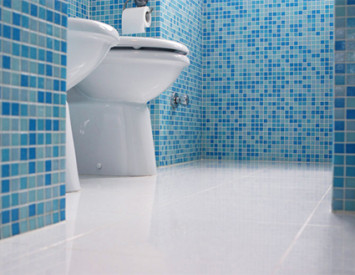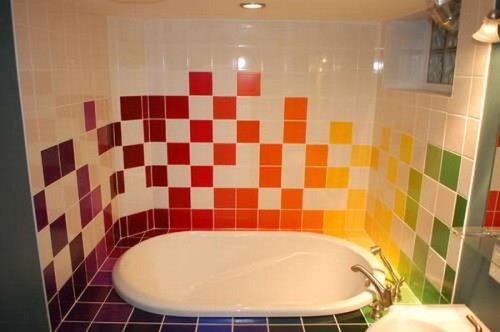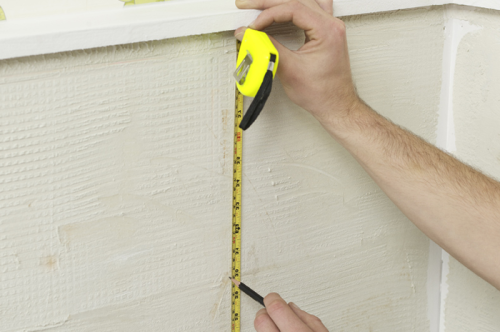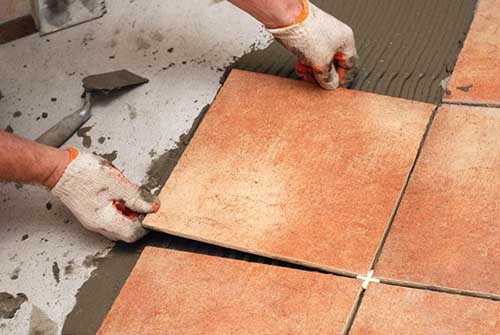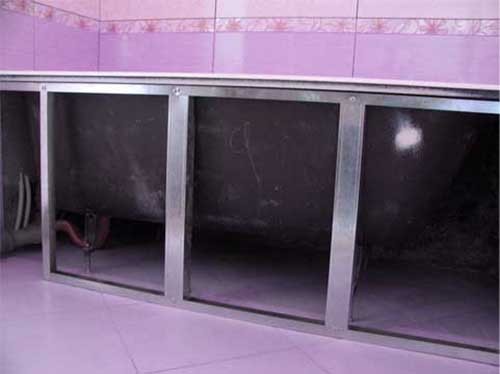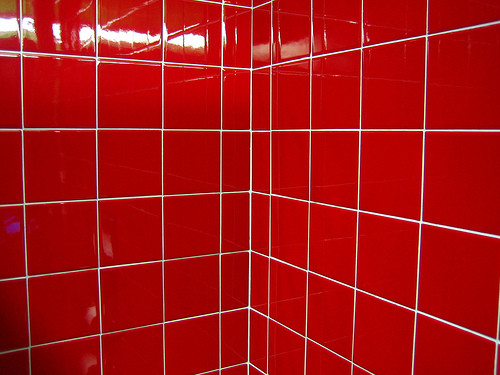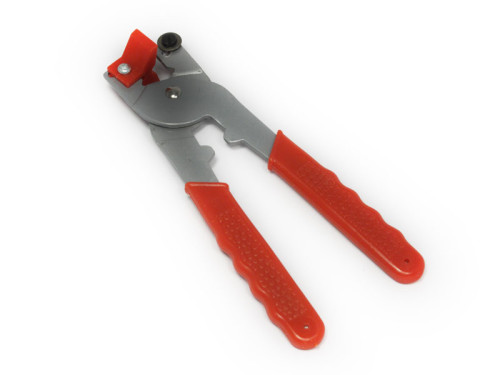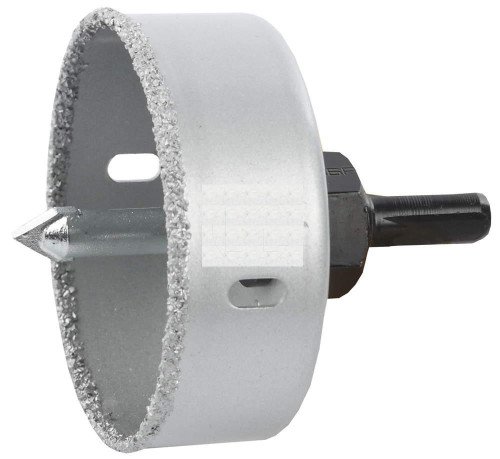The tile is perhaps the best finishing material for the bathroom available today. It is ideal for rooms with increased humidity - it does not absorb moisture, withstands cleaning with aggressive chemicals, serves for a long time, and if you choose it correctly, decorates the room. It was not for nothing that we mentioned the intricacies of choice, since the good half of the successful decoration depends on them. In this article you will find answers to all questions regarding the correct choice and installation of tiles in the bathroom.
Content
The laying of the tile in the bathroom itself is quite simple, and even a non -professionals will cope with such a job, so we decided to start the article with advice on choosing finishing materials. Not only the aesthetics of the future interior, but also the complexity of installation depends on this. So, for example, if you really like large tiles, but the bathroom has, to put it mildly, a modest square, then such a finish will turn it into an even darker room, and when laying out it turns out that you can’t do without cutting tiles.
Preliminary layout allows you to choose the optimal amount and size of the tile specifically for your bathroom. To do this is quite simple: you need to calculate the area that is subject to finishing, and then compare it with the size of the selected tile model. It is best to do such work in a computer program for interior design - for clarity. But if the charms of interactive progress do not seduce you, you can simply arm yourself with a pencil and make an inconspicuous preliminary marking on the wall in accordance with the dimensions. This principle will help you measure any bathroom for any tile.
As you know, the bathroom is a specific room with high humidity, therefore the tile for it should be difficult. What you need to pay attention to when choosing:
- Strength - any tile is classified according to five classes of wear resistance, where the most durable products belong to the last fifth grade. They should be chosen for floor cladding in rooms with increased cross -country ability. The cost of such a tile is quite high, but, fortunately, it is not necessary to buy such a strong coating for the bathroom. For the floor, tiles of grade 3 are suitable, and for walls - 2 or even 1.
- Moisture absorption - despite the seeming absolute hydrophobic of the tile, he can nevertheless absorb a certain amount of water. This happens very slowly and completely imperceptibly, but moisture absorption depends on the composition of the product. There are 4 classes of moisture absorption, and the most waterproof products have the first class (the information is indicated on the packaging by Roman numbers). A Latin letter A or B is always next to the class number. In the first case, it means that the tile is made by extrusion, in the second - pressing. For a bathroom with its special "climate", products with the labeling IA, IB, IIA, IIB are suitable.
- Dimensions - we have already said that a large tile should not be chosen for a small bathroom, otherwise it will visually make the space even less. In this case, it is better to limit yourself to conventional products or make a way of small tiles in the bathroom with your own hands.
- Form-traditionally, the tile has a rectangular or square shape, but if you want something extravagant, you can find polygons, triangles and other unusual figures on sale. It is worth immediately to warn that for the original finish such tiles will have to be paid not only from your own wallet - it will take much more time for installation, and the work will require professional skills. Therefore, if you never put the tiles, it is better to start with products easier. By the way, with their help you can create original interior compositions and “play” with visual perception. So, if you lay a rectangular tile vertically, the room will seem higher than it really is.
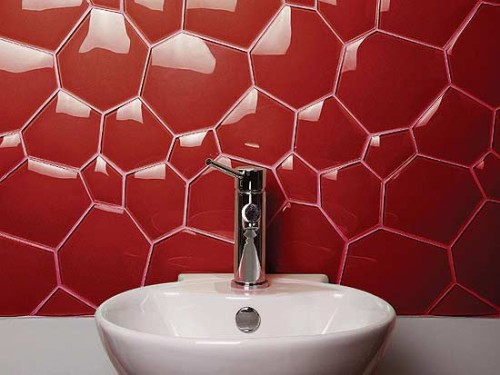
- Color - here you need to build on not only from personal preferences, but also for practical considerations. If the house has small children who strive to cover the wall with a dental paste or to do something worse, it is better to refuse a stylish black matte finish. In addition, the bathroom is a place where they wake up in the morning and prepare for bed in the evenings, and therefore it is better that it reigned with a light, but if possible, a calm atmosphere. Decorative wall tiles in the form of panels are popular.
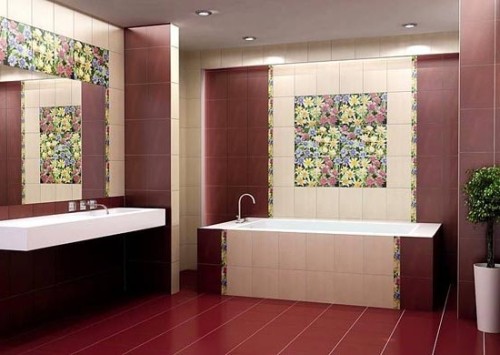
- The relief is the last on our list, but no less important position than the same strength. In the bathroom, something is constantly spilled, and therefore it is good for the floor to be nonsense. Otherwise, you will have to lay all kinds of rags, rugs or walk very carefully, risking slipping. Anti -slip embossed tile can cover the entire floor, and maybe only the part that adjoins the bathroom or shower.
What glue is suitable for the bathroom?
The insightful reader will probably think that if a special tile is needed for the bathroom, then the glue should be appropriate for it, and will be absolutely right. The adhesive mixture should be selected not only for considerations of increased humidity, but also depending on the material from which the walls are made. For concrete, for example, there is nothing better than a cement basis.
The mixture is applied to the surface of the wall or the back of the tile. There are no strict rules here, and every master makes how convenient he is. But for application, it is recommended to use not ordinary, but a toothed spatula in order to get high -quality adhesion.
The floor of the bathroom will be subjected to much greater loads than the walls, so the glue must be selected separately for it. By the way, this must also be done depending on the material of the base. The best option would be a glue flexible mixture (universal or specifically for concrete, warm floors, metal or wood).
Installation of tiles in the bathroom
When you have decided on the choice of tiles, you can start preparatory work - make measurements of walls and floor. If you also plan to finish the space between the floor and the bathroom itself, you will need to make a special box.
Stages of preparatory work:
- Measure all surfaces requiring decoration, a building level. They should be perfectly even, otherwise the tile will not hold. If the differences are more than 2-3 mm, the surface must be leveled with drywall plates. There is a special drywall for rooms with high humidity, so when buying, take into account this moment. Buy the usual cheap material, and the walls will very quickly become unusable - the gypsum will damp, soften, and the tile will fall off. If we are talking about a very small area, it is easier to align it with special plaster mixtures.
- Remove the old tile, if any. This work is not easy, noisy and dusty, so arm the chipper, warn your neighbors and gain patience. If a mechanical tool could not be obtained, an ordinary crowbar and a hammer will come to the rescue.
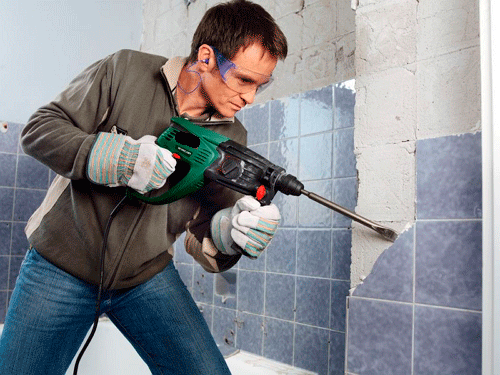
- When the wall is even and without defects, cover it with a primer of deep penetration. It will create additional protection against moisture and provide good adhesion with an adhesive mixture for tiles. The primer should be precisely waterproof, and even better - antiseptic so that the walls are not covered with mold.
Laying on the walls
Laying tiles in the bathroom with your own hands always begins with the walls, then the work goes to the floor, and lastly they finish the box. The first element can be laid from the corner, the bathroom itself or near the floor, but wherever you start, it is necessary to make chalk markings in accordance with the dimensions of the tiles.
Useful advice: before gluing the tile, lay the lower row along the wall without solution, so that it is visible whether all elements are placed, or one of them needs to be trimmed. How to cut tiles correctly, we will tell you at the end of the article.
At the very bottom, fix a wooden rail or a plastic profile - this will be a support for the first row. In no case should you lean the tiles on the floor. Remember that the floor has not yet been lined, and the direct close contact of two tiled surfaces will lead to premature wear of both. Take a plumb line and draw a vertical line that will help control the evenness of the styling.
Useful advice: if you use tiles of various colors or lay out a mosaic pattern, it is better to mark the entire wall and immediately indicate with chalk the place of attachment of parts of a certain color.
The video below is a tile to lay tiles in the bathroom with your own hands:
Installation tips:
- Experts recommend starting laying tiles on the wall from the second row from the floor, based on a pre -attached rail. The first row is still missing.
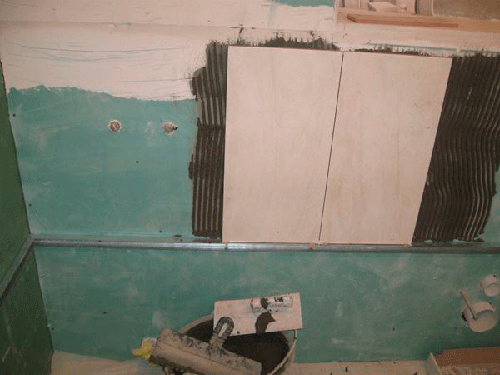
- In this case, the adhesive mixture is better to spread on the tile, but on the wall, using a gear spatula. In this case, it is necessary to capture the area, the size of which slightly exceeds the dimensions of the tiles by several centimeters on each side.
- Do not press the tile against the wall too much, otherwise it can crack.
- After the installation of the next tile or row, immediately remove the adhesive with a damp rag - when it dries, it will not be easy to do.
- Do not forget to insert dividing crosses between tiles. The width of the seam should be 3-5 mm.
- After laying each row, especially the first, check its horizontal level by the construction level. Even if the first row turned out to be perfectly even, this does not guarantee that the same thing will happen to the rest. Juried can occur due to defects in the tile itself. When buying the differences in measurements are invisible, but this often happens with products of domestic manufacturers.
To lay tiles in the bathroom in the corners with your own hands, it often has to be cut. The same applies to complex places, for example, for the toilet, or near the pipes. It will not be possible to avoid this and when facing sockets.
Laying on the floor
When the walls are over, you can proceed to the lining of the floor. You also need to start work with the preparation of the base - it should be perfectly even, clean and dry. It is more difficult to achieve this on the floor than on the walls, therefore, often the issue is resolved using leveling mixtures and cement screeds.
How to lay tiles on the floor of the bathroom with your own hands:
- Draw a chalk line from the laid edge of the tiles of the first row of the wall.
- Place the location of the elements that will differ from the main ones if you lay out the drawing.
- Start laying from the farthest corner from the entrance to the bathroom.
- It is necessary to make a preliminary layout so that at the entrance a whole element is placed (intolerated).
- When laying out and calculations, also take into account the width of the tile joints.
- The solution is also more convenient to apply to the surface of the floor, and not on the tile. At the same time, it is better to capture an area equal to the area of \u200b\u200bone element, and not to coat several rows at once - you simply will not have time to close it until the glue dries.
In more detail, the process is shown on the video on laying tiles in the bathroom with your own hands:
Laying around the bath
If you want to close the space under the bathroom (most often there is quite little space, so the cabinets for storing household utensils will not work), you will need to first build a frame for the box, and then sheathe it with even panels. To create such a screen, you can use the same moisture -resistant drywall or polystyrene (polystyrene foam) blocks. Also, finished bath screens can be found in specialized stores (whole and sliding).
The frame can be made of metal profiles. If you have sheathed it with drywall, you can immediately lay the tile. Installation technology is no different from working with walls.
Grout of the seams
Finally, when you are surrounded by a tile from all sides, you can proceed to the final part of the work - grout of the seams. This needs to be done only after the glue dries completely, that is, a few days after laying. If you wipe the “fresh” tile, it can shift.
There are as many grouts for tiles as the tile itself are different compositions, colors and cost. But again - for the bathroom, moisture -resistant compounds should be selected on a cement, epoxy or silicone basis. The choice of color depends on the color of the tile. You can choose an inconspicuous grout of a neutral shade (white or grayish), or you can emphasize the beauty of the tile, bordering it with contrasting seams. Yellow tiles with a green grout look very juicy, and a black and white combination will create a unique elegant style.
How to do stitches after laying tiles on the floor of a bathroom with your own hands:
- Complete the lined surface of the remains of glue and dust. With the latter, an ordinary vacuum cleaner will help you very much.
- Cumble the edges of the tiles with masking tape, so that then again you do not have to wash it.
- To apply a grout, you will need a rubber spatula. Scoop a little mixture for them and, with a light pressure, run around the seam to press the grout inside.
- Remove the surplus by the same spatula, having spent again at the seam, but without much pressure.
- When the grout is completely dry, remove the masking tape and remove the remaining the mixture with a damp cloth.
How to cut tiles correctly
As you can see, the laying of ceramic tiles itself is not so complicated if you prepare properly and correctly calculate its number. The only thing that can cause difficulty and that confuses many self-taught masters is the need to cut tiles. This will require special tools and some skills to work with them.
It is easy to cut a thin wall tile with an ordinary glass cutter, which cannot be said about strong floor products. It is good that there are no rosettes on the floor and there are not so many complex places, so try to do the flooring of floor tiles in the bathroom if possible so that it does not have to be adjusted.
If you at least once cut the glass with a hand tool, there should not be problems with tiles, because the technology is almost the same. First, you need to mark on the glazed surface, after which with force once through it with a glass cutter. In this case, the tile should lie on a flat surface. When you managed to cut a strong layer of glaze, it remains only to make a neat break on the line.
Useful advice: it is better to get a tool for cutting tiles rather than glass, since the diameter of the sharp wheel has much larger diameter.
If they were limited to this difficulty, then there would be nothing to talk about. But in addition to even sections in the tile, you have to make curly holes for sockets, wires or to circumvent water pipes. Such work will require great effort and concentration. First, you need to mark, then with pressure, draw a tile cutter with a wheel, then bite off a small piece with pliers, until the desired shape of the product is obtained. Of course, the cut in this case will be uneven, and therefore it needs to be smoothed out with a file or sandpaper. It is much more prompt to do this with a special circular diamond nozzle on a drill.
Another useful video summarizes all the above information, which is about the intricacies of choosing and tile laying technology:
